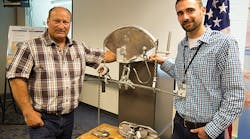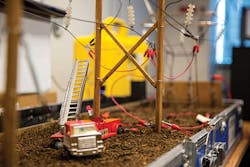Thriving companies unleash creativity and passion into the marketplace so they can thrill their customers. This is especially important in our power-delivery space because it is such a relationship-oriented business. We need the whole to be bigger than the sum of the component parts. We need to collaborate to succeed. And those of us who work in T&D are so unique and have so much more to offer than can be stated in a one-size-fits-all job description. I believe in the power of the individual. In my wanderings, I am always running into people with true passion, people who care, people who are willing to do what it takes to move our industry forward.
Recently, I was in the Denver, Colorado, area and dropped in on the Western Area Power Administration (WAPA) headquarters in Lakewood. I know Mark Gabriel, the administrator at WAPA, from his days at Black & Veatch, so I stop in every chance I get. I’ve always liked working with WAPA engineers and line workers, because they are always open to trying new ways of doing things and thus always have new things to share. We usually cover their transmission construction projects in Transmission & Distribution World, but we also track progress in operations and maintenance.
One individual who continues to impress is Ed Hunt, a line foreman out of WAPA’s Cheyenne, Wyoming, field office. He doesn’t really want any attention so he will probably be irritated when I mention him. But he is a friend, so I’ll mention him anyway.
Ed is the chairman of the IEEE ESMOL committee that works to improve the safety and operations practices for overhead lines. Ed is a field guy, so his input is invaluable. When our industry discovered that non-ceramic transmission line insulators were deteriorating to the point of being a safety hazard to workers, Ed wrote an editorial for me stating that we needed to come up with a way to keep linemen safe. He then went on to work with EPRI and EPRI contractors to push for the development of a device that could check the integrity of a non-ceramic insulator prior to initiating energized line work. That device is now on the market. Way to go Ed!
Now back to my visit with Gabriel.
Being that I am a tech geek, Gabriel and I soon found ourselves talking about innovation and technology. Mark informed me that WAPA had just held its inaugural Technology and Innovation Summit in Lakewood this past May. WAPA brought in 100 or so employees and another 20 connected via teleconference. The summit was conceived as an opportunity to recognize and inspire creativity and innovation in the development, testing and implementation of emerging technologies and enhanced work practices.
Gabriel believes that while innovation cannot be taught, it can be unleashed, and it takes the right environment to open minds to new ideas. He loves working at WAPA because the organization is always evolving and innovating and he sees that as something really special happening at WAPA. Gabriel appreciates the commitment and dedication of WAPA staff to finding better ways of doing things so they can make a bigger difference. And Gabriel believes that innovating is also fun.
Gabriel was thrilled that 64 nominations were turned in. To give you a flavor of the event, here are a few of those individuals who were acknowledged:
- Ronald Burbridge — Ronald invented a device that allows an overhead static wire on a wood H-frame to be disconnected under tension and then lifted so that the static connection hardware can be more easily replaced.
- David Katich — David was innovative in developing a virtual high-resolution video system that enables office employees to have access and visibility on system conditions without always having to go out into the field.
- Lane Cope, John Quintana and Gary Zevenbergen — In this case, three amigos demonstrated innovative efforts to develop and calculate new safe minimum working distances for maintenance employees working with high-voltage equipment.
- Anne Anderson, John Athanasiou, Grover Bray, Carol Hammans, James Higgins, Timothy Padden, Jon Ridout, Steven Smith and David Tucker — Now this team is almost as big as the task at hand: to develop a WAPA-wide approach to identify and automate the collection and monitoring of dissolved gases to measure the health of transformers.
Of course, no company works in a vacuum, and Gabriel invited Terry Oliver, Bonneville Power Administration’s (BPA) chief technology innovation officer, to share his thoughts on the power of innovation. I know Oliver and people in his group. Oliver empowers his team to create, and at the same time, he has a system to track the value delivered to BPA by these innovations.
Oliver believes most innovation is additive. He used the synchrophasor as an example of a game-changing technology. He also shared counterintuitive lessons learned from BPA’s 10-year-old innovation program. One of the most important lessons is to embrace failure. When Oliver started the innovation program at BPA, he promised executives an 85% failure rate. “I beat it,” stated Oliver. “I have a failure rate of 90%.” With failure as a legitimate option, BPA has a mantra: Fail Early; Fail Cheap. Oliver emphasized the importance of focusing on mission-related problems, and the payoff for BPA has been substantial. Oliver says BPA has invested about $70 million over the past 10 years, and that investment has generated $280 million in benefits, even with a 90% failure rate.
I’m sure this won’t surprise you, but the biggest challenge Oliver shared has been internal resistance to change. This led BPA to look at changing the culture of the company with a focus on change management and continuous improvement. Sacramento Municipal Utility District (SMUD) Chief Grid Strategy & Operations Officer Paul Lau also shared his thoughts on innovation. He highlighted that SMUD’s board of directors set a goal of 95% customer satisfaction for everything they do. For example, SMUD chose to address residential solar by becoming an enabler to help customers accomplish their personal energy goals. This required change management processes to be absorbed internally so that innovations could be incorporated into the culture of the organization.
I visit a lot of utilities and see innovative ideas and insights that can pop up anywhere in an organization. In fact, the case studies we run in T&D World are selected so innovations developed in one utility can be shared with all.
The Technology and Innovation Summit was not just about handing out awards. Attendees chatted with individuals manning the 20 or so displays highlighting innovations at WAPA.
Electrical engineer Gary Zevenbergen stepped it up and provided a demonstration of ground potential rise. A video of insulator and conductor ballistics testing was a big hit. Not all utilities are of a size that they can launch their own innovation summit, but we all have the opportunity to share with one another. In fact, we have an event coming up later this year that I would recommend you consider attending.
After a hiatus of a few years, I am excited to report that American Electric Power (AEP) is teaming up with the IEEE ESMO committee to bring back the ESMO conference. I love going to this event. This is a real hands-on event like nothing else in the power industry. The outdoor portion of this event is being held at AEP’s Bixby substation. You will get to see the latest field practices being demonstrated in real time.
Here is a partial list of planned field events:
• Installation of an aerial marker ball by helicopter
• Change out of an energized insulator using a robotic arm
• Installation of a conductor sleeve by implosion
• X-ray of an energized transmission line by helicopter
• Replacement of a 115-kV crossarm with a truss arm
• Fall protection and self rescue on a 115-kV wood pole
• Measure of corrosion on a transmission wire
• Suspension of V-string glass insulators
• Emergency restoration and installation of a structure.
Innovation can occur at all levels within a company, but having worked at a research lab, I can confirm that innovation does not occur in a vacuum. We must expand our circle of contacts if we are going to expand our impact. Kudos to WAPA, BPA and AEP for encouraging and sharing innovation.



